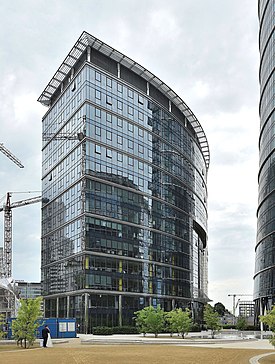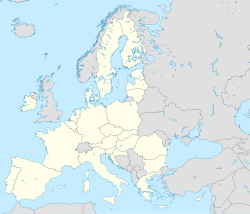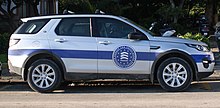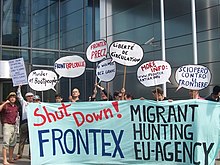
Search and rescue (SAR) is the search for and provision of aid to people who are in distress or imminent danger. The general field of search and rescue includes many specialty sub-fields, typically determined by the type of terrain the search is conducted over. These include mountain rescue; ground search and rescue, including the use of search and rescue dogs ; urban search and rescue in cities; combat search and rescue on the battlefield and air-sea rescue over water.

The Dublin Regulation is a Regulation of the European Union that determines which EU member state is responsible for the examination of an application for asylum, submitted by persons seeking international protection under the Geneva Convention and the Qualification Directive, within the European Union.

The visa policy of the Schengen Area is a component within the wider area of freedom, security and justice policy of the European Union. It applies to the Schengen Area and to other EU member states except Ireland. The visa policy allows nationals of certain countries to enter the Schengen Area via air, land or sea without a visa for up to 90 days within any 180-day period. Nationals of certain other countries are required to have a visa to enter and, in some cases, transit through the Schengen area.

Law enforcement in Croatia is the responsibility of the Croatian Police, which is the national police force of the country subordinated by the Ministry of the Interior of the Republic of Croatia, carrying out certain tasks, the so-called, police activities, laid down by law.

The Schengen Area encompasses 29 European countries that have officially abolished border controls at their mutual borders. As an element within the wider area of freedom, security and justice (AFSJ) policy of the European Union (EU), it mostly functions as a single jurisdiction under a common visa policy for international travel purposes. The area is named after the 1985 Schengen Agreement and the 1990 Schengen Convention, both signed in Schengen, Luxembourg.

The area of freedom, security and justice (AFSJ) of the European Union (EU) is a policy domain concerning home affairs and migration, justice as well as fundamental rights, developed to address the challenges posed to internal security by collateral effects of the free movement of people and goods in the absence of border controls or customs inspection throughout the Schengen Area, as well as to safeguard adherence to the common European values through ensuring that the fundamental rights of people are respected across the EU.

The Directorate-General for Migration and Home Affairs is a Directorate-General of the European Commission. The role of the body is to ensure the EU's security, to build a common EU migration and asylum policy, and to promote dialogue and cooperation with non-EU countries. Thereby, it contributes to the area of freedom, security and justice (AFSJ).

The European Union Agency for Asylum (EUAA) is an agency created by European Union Regulation 439/2010 within the area of freedom, security and justice framework to increase the cooperation of EU member states on asylum, improve the implementation of the Common European Asylum System, and support member states under pressure.

The border of the European Union consists of the land borders that member states of the EU share with non-EU states adjacent to the union. The EU shares land borders with 21 countries and 3 dependencies.

The 2015 European migrant crisis was a period of significantly increased movement of refugees and migrants into Europe, namely from the Middle East. An estimated 1.3 million people came to the continent to request asylum, the most in a single year since World War II. They were mostly Syrians, but also included a significant number of people from Afghanistan, Pakistan, Iraq, Nigeria, Eritrea, and the Balkans. The increase in asylum seekers has been attributed to factors such as the escalation of various wars in the Middle East and ISIL's territorial and military dominance in the region due to the Arab Winter, as well as Lebanon, Jordan, and Egypt ceasing to accept Syrian asylum seekers.

This is a timeline of the European migrant crisis of 2015 and 2016.

Fabrice Joël Roger Leggeri is a French senior civil servant who was Director of the European Border and Coast Guard Agency (Frontex) from 2015 to 2022.

The European Union Agency for the Operational Management of Large-Scale IT Systems in the Area of Freedom, Security and Justice (eu-LISA) is an agency of the European Union (EU) that was founded in 2011 to ensure the uninterrupted operation of large-scale IT systems within the area of freedom, security and justice (AFSJ), that are instrumental in the implementation of the asylum, border management and migration policies of the EU. It began its operational activities on 1 December 2012.
The migration and asylum policy of the European Union is within the area of freedom, security and justice, established to develop and harmonise principles and measures used by member countries of the European Union to regulate migration processes and to manage issues concerning asylum and refugee status in the European Union.
Operation HERA is a joint maritime operation by the European Union established to manage migration flows and stop irregular migrants along the Western African Route, from the western shores of Africa to the Canary Islands, Spain. The operation was implemented following an increase in migrants arriving at the Canary Islands in 2006. It remains an annual operation managed by Spain and the European Border and Coast Guard Agency (FRONTEX).
Joint Operation Themis is the successor to Operation Triton, and began in 2018. This was after Operation Triton in turn had followed Operation Mare Nostrum in 2014. All of these operations have been run by the European Border and Coast Guard Agency of the European Union, also known as Frontex.
In migration, pushback is "a set of state measures by which refugees and migrants are forced back over a border – generally immediately after they crossed it – without consideration of their individual circumstances and without any possibility to apply for asylum". Pushbacks violate the prohibition of collective expulsion of asylum seekers in Protocol 4 in countries party to the European Convention on Human Rights and often violate the international law prohibition on non-refoulement.
Since at least 2008, Greece has pushed back tens of thousands of migrants, especially at the Evros border with Turkey and in the Aegean Sea. On land, the pushbacks involve taking people who have arrived at the Greek side of the border and transferring them to the Turkish side; most cases involve some form of abuse. Maritime pushbacks typically involve taking migrants who have either entered Greek territorial waters or landed on Greek islands and depositing them in Turkish territorial waters on craft without any means of propulsion. The number of pushbacks has increased following the European migrant crisis and breakdown in EU–Turkey relations in 2020. This incident occurred as a result of Turkey ceasing to prevent migrants from leaving for the European Union in February 2020, and in some instances actively encouraging them.
The European Union response to the 2015 migrant crisis focused on how the countries organized the efforts in response to the 2015 European migrant crisis at the EU level. The European Commission in May 2015 proposed distributing the incoming refugees based on GDP and population. This proposal was divisive with Slovakia, Hungary, Romania and the Czech Republic refusing any refugees. Some nation states then called on the EU to reduce funding for member countries who did not want to share burdens and didn't share "values...need to start asking themselves questions about their place in the European Union". This attempt to coalition build failed, the European Commission proceeded to strengthen existing systems such as the Common European Asylum System (CEAS), reforming the Dublin Regulation and centralizing the asylum process. There was also challenges to the European borders which came from the Mediterranean Sea; as a response the European Border and Coast Guard Agency engaged in a new operation called Operation Triton.



























